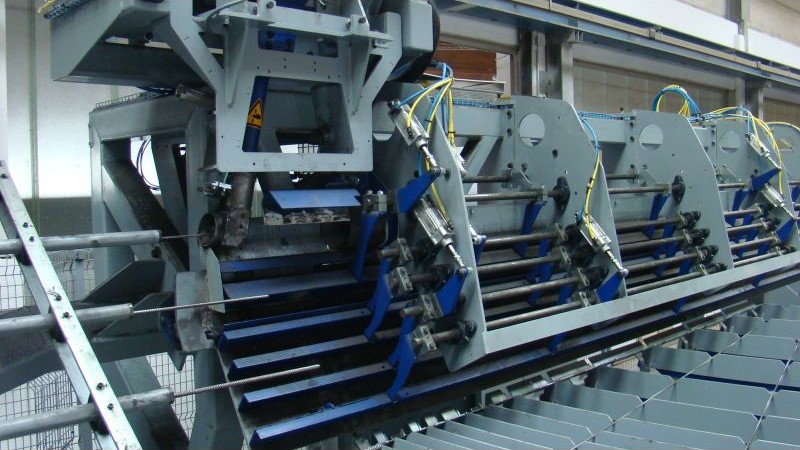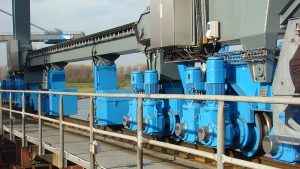What is this article about?
If a machine is faulty, this can lead to conflicts that can negatively impact productivity and cause costs. Conflicts in and between companies are part of everyday business life. They hold considerable potential for creativity and innovation, but they can also destroy values and, in extreme cases, even destroy livelihoods. In this article, you will learn how to resolve such technical conflicts and avoid legal disputes. Here you will find tips and tricks to solve faulty machine errors professionally as well as effectively and efficiently.
The classic in the "machine error"
The history of damage to a machine, a machine fault and any resulting consequential damage is always identical.
The operator has submitted to the manufacturer a technical Machine or plant ordered. “Maybe” there was even a specification. In numerous cases there is not even that, but often only the Order based on an offer. Very often prevail, especially in the occurrence of any technical problem a completely different Understanding of the content of the order, i.e. the technical Specifications, and the performance of the delivery. In 90 % of the here cases that are processed, the fronts quickly harden. Thereby take just as both parties – almost always – quickly adopt the following positions:
Häufige Parteienpositionen beim Maschinenfehler
Einige “klassische” Vorwürfe von Parteien bei der Diskussion “Maschinenfehler”
Was? Besteller / Betreiber Hersteller / Lieferant
Ergebnis unerwartet Fehlerhafte Konstruktion / Entwicklung Unqualifiziertes Personal
Stillstände Instruktionsfehler Fehlerhafte Wartung
Verfügbarkeit nicht erreicht nicht geliefert wie bestellt Fehlerhafte Nutzung
Konstruktionsfehler Absprachen nicht eingehalten War nicht vereinbart
Lawyers come into play
It often doesn’t take long for lawyers to be brought on board by a party. Sometimes it is initially “hidden” the case. The first pleadings are still exchanged on the stationery of the respective party. Very quickly, lawyers then also reveal themselves.
Thus, there is a significant increase in costs and an increase in the risk of litigation costs. The following graph shows the costs of litigation if one were to be awarded for a certain amount in dispute in the 1. or in the 2nd instance loses. This does not even take into account expert costs. In almost all technical litigation involving machinery or discussion of machine defects, alleged or even existing product defects, technical experts are required in court to assist the court in the role of a neutral aid in legal decision making.
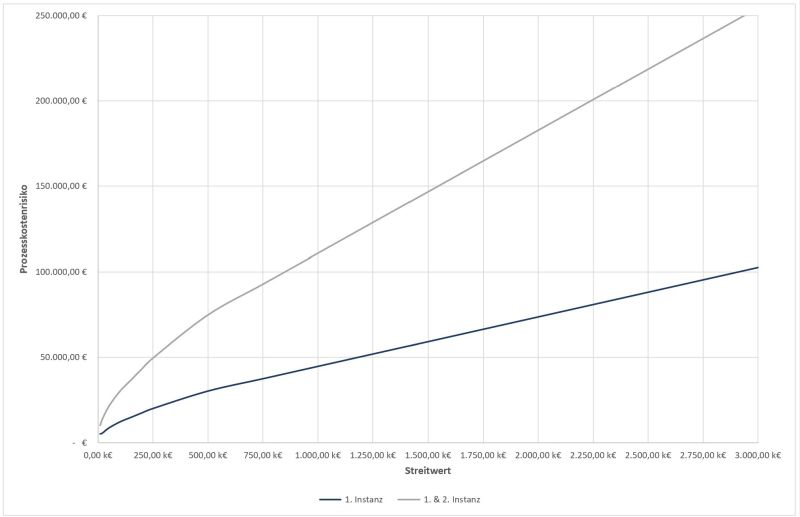
Litigation cost risk (court costs and lawyers) depending on instance and amount in dispute
Those who have decided to take this step as management literally can’t get out of it. High ancillary costs are “automatically” generated.
My experience from over 20 years of litigating technical disputes in court shows:
In 9 out of 10 cases, the end result is a court settlement. Almost never are technical disputes involving machinery and equipment decided by a court of law.
From my point of view, therefore, litigation to clarify (complicated) technical issues and especially in the case of high amounts in dispute is not recommended.
Technical translations are necessary: Engineering - Law - Engineering .....
In a technical dispute in court involving lawyers, multiple “translations” are necessary.
Since the dispute is “clarified” against a legal background, the responsible technician (engineer, technical department manager, technical manager) must first explain the technical facts to his own lawyer(s).
Lawyers are proven experts in the law, but of course not in other fields.
If the lawyer believes he has grasped the underlying (technical) facts, he will package this into a legal brief. This then ends up in a court of law. As a rule, some pleadings are subsequently exchanged. All this is done on a purely legal basis. Finally, the court issues an order for evidence and appoints an expert to provide a court opinion.
This is an attempt to clarify the disputed legal fact formulate in the form of (technical) evidentiary questions that are important for the legal processing of the facts. The lawyer formulates in his words. Finally, the technical expert must understand and answer the technical questions in the “legal wording” from the legal evidence decision. In some cases, evidentiary decisions are difficult to understand even for experienced publicly appointed and sworn court experts, even after reading them several times.
The experienced court expert will eventually turn to the court to clarify any ambiguities in the evidence order that exist for him.
Then the expert opinion is given. Finally, the technical opinion must be explained by the parties’ technical staff to the parties’ respective counsel. So there is another necessary “translation”. In a further step, the case is again heard by the court and the expert is questioned if necessary.
What is described here in a few sentences can take years. Especially with challenging technical issues and/or complicated parties, there is a tendency to have to go on and on. As a consequence, such conflicts have maneuvered themselves into legal areas from which there is hardly a quick way out and in any case no cost-effective way out. This way means high additional costs and quite a lot of time. You are no longer “allowed” to lose. This is anything but a joy for all involved. The bottom line:
Litigation is usually a lengthy and expensive affair when the amount in dispute is high in the area of machinery and equipment, and when a machine defect exists or is alleged. In the vast majority of cases, such litigation ends in court in settlement.
Solve technical conflicts alternatively
Much less expensive options than litigation are available for resolving technical disputes. A legally binding solution is the arbitrator’s opinion. In addition, there is also the means of mediation, provided that both parties are fundamentally willing to engage in it and, ideally, in cooperation with a technical mediator, try to find a joint solution to the disputed points with which both parties can live well in the end.
Arbitrator opinions or technical mediation solve technical-legal conflicts quickly and, in almost all technical cases involving machinery and equipment, more cost-effectively.
Arbitrator's opinion for the resolution of technical conflicts
Arbitration opinions are very often not recommended by party lawyers. I explain it to myself in such a way that perhaps the legal “fear” is behind it, by arbitrator’s opinions facts can be created, which are then legally binding valid, however, as a rule no longer can be contested. Thus, in my view, the lawyers who may have been involved up to this point lose control of “their process.”
General information on the process of an arbitrator ‘s award can be found here.
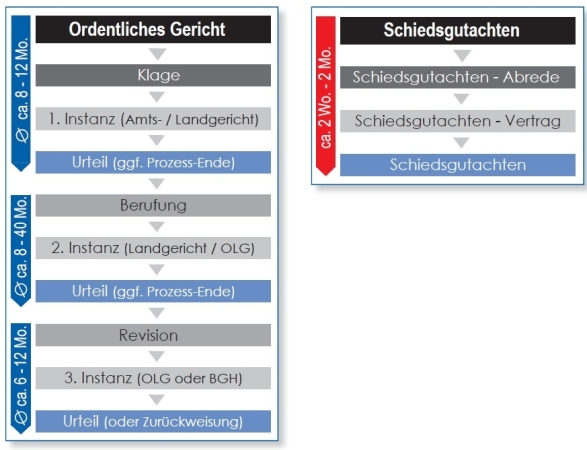
The arbitrator’s opinion can be significantly less expensive than litigation. However, if the parties want clarification down to the deepest technical detail in the case of a machine fault, these costs can also become quite high. In a recent case, I was confronted by both parties with 150 technical issues to be resolved for a planned arbitration opinion. Since technical issues cannot usually be clarified with technical certainty by “looking at them,” so many technical questions generate considerable ancillary costs, for example for testing, time, laboratory costs, etc. Clarifying so many questions technically does not make economic sense in most cases.
Mediation for the clarification of technical conflicts concerning machines, plants and technical faults
Mediation, i.e. mediation by a third party who has no decision-making authority, opens up additional and efficient ways of finding solutions, which can have a positive impact on both internal company processes and a company’s reputation.
In many cases, technical mediation enables quick and cost-effective dispute resolution that preserves business relationships as well as company operations.
Mediation is also profitable for companies in several respects, especially in the international environment. Wherever in business life different legal systems meet in case of conflict, a solution of the conflict by means of mediation is advantageous, because the solution of the parties is found and a discussion of different legal systems is not necessary. This saves time and money, especially in an international environment, and does not tie up unnecessary resources.
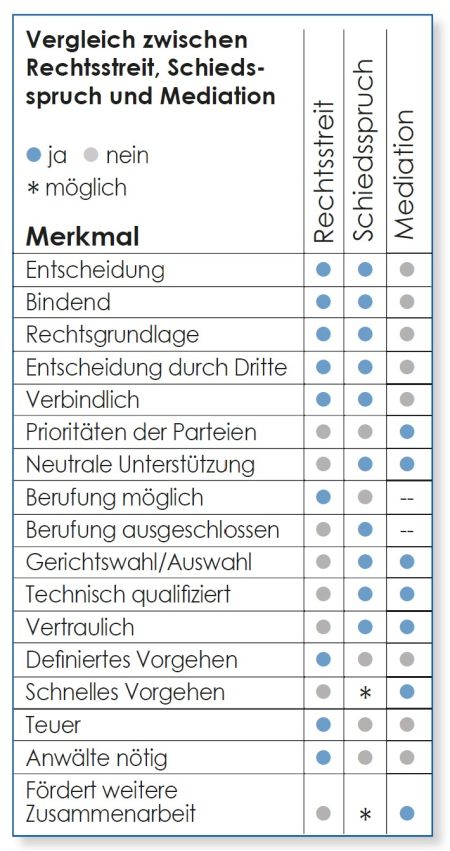
In the current case, which was initially to be resolved in a binding manner by an arbitration opinion with 150 issues to be resolved, the parties switched to mediation for cost reasons.
The various questions were grouped into seven overarching themes. Independent mediations have been or are being conducted for each individual item. At the end of each mediation so far there is a schedule for the agreed further procedure on the respective point. This mediation has not yet been completed. The parties communicate with each other. The interaction with each other is professional and businesslike.
In the course of the technical discussions, the actual issue between the parties inevitably becomes technically clearer. This is often omitted in legal disputes.
In the course of the technical discussions, the actual subject matter between the parties on certain points inevitably becomes technically clearer. It is discussed technically as well as solved and not legally.
It is therefore very important that all parties involved speak one language, namely the technical language, and that legal boundary conditions are completely in the background during the solution. Provided there is a solution and in the end both parties are satisfied with it, the problem is solved. The way to the court still remains possible in case of doubt.
So if you want to settle a technical conflict concerning machines or plants out of court, you are in very good hands with the procedure of technical mediation by an expert mediator at relatively low costs. The prerequisite is that both parties agree to it.
Understand causes of machine faults
In litigation, technical causes are often sought. However, there are numerous cases in which the exact causes can no longer be found or proven. Courts can also decide on this basis. In case of doubt, the party who has the burden of proof and cannot provide the evidence will be “caught”.
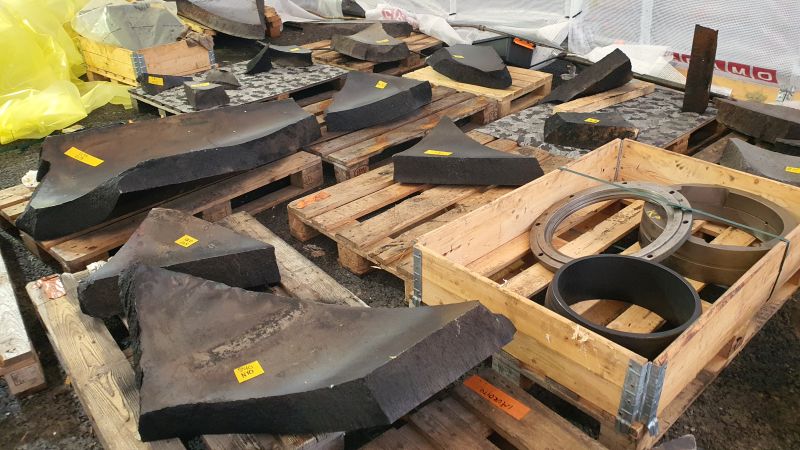
Before you can resolve technical conflicts on faulty machines , you need to understand the causes of machine faults. Machine failures can be caused by various factors, such as wear, lack of maintenance, overloading, incorrect operation or, of course, a faulty design. It is important to identify the cause of the error to find an effective solution and avoid future problems.
In the process of mediation, there can also be solutions without having clarified the actual cause of a problem in detail. This is also an advantage of mediation. Basically, you have to consider:
Numerous cases of technical damage to machinery and equipment can no longer be clearly clarified from a technical point of view.
The image above shows such an example, where the cause remains unexplained.

